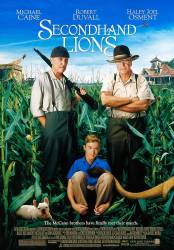Continuity mistake: When Walter puts the blanket over Hub's shoulders one can tell from the reflection that the moon is across the lake. However, Walter's shadow on hub indicates that the moon is behind him. (01:06:00)
Continuity mistake: When Hub and Walter are talking by the lake, Hub's, and later Walter's, blanket repositions itself each time the camera cuts back. (01:08:45)
Continuity mistake: When Garth gets the money from the cellar under the barn he leans a pile of wads upright against his petroleum lamp. When the camera angle changes the wads are lying on the floor. (01:13:20)
Continuity mistake: When Walter's mother last drives off, all the dogs jump at Walter's window, then sit right next to the car. When the car pulls away however, the dogs are a few feet back and not in a line, but when the camera cuts back to the dogs, they are where they were to begin with. (01:26:25)
Continuity mistake: After Walter jumps out of the car to go back to the Uncle's. Walter is running along the left side of a bridge. There are two wide shots from below the bridge showing him running on the right side of the bridge. (01:28:05)
Continuity mistake: After receiving the sheriff's phone call, when older Walter drives toward his uncles' house, in the exterior shot the rearview mirror is gone, only to suddenly appear in the interior shot and when he gets out of the car. (01:37:20)
Continuity mistake: At the diner when the punk disturbs Hub, Walter is holding his bottle with both hands. But in an overhead shot, he holds it only with one and the other arm is under the bar.
Other mistake: The uncles fire shotguns a lot in the movie, but the guns have no recoil. Shotguns kick very hard which would be easily seen.
Continuity mistake: In the scene where the skeet shooting salesman is explaining his wares, the trunk is open. In the immediately preceding shot, the trunk is closed.
Factual error: In one shot you will see round hay bails that did not exist during the time period.
Suggested correction: Early round balers, like the one that went into production in 1947 and sold like hotcakes amid the postwar economic boom, produced fairly small bales, which farmers still had to move around by hand.





